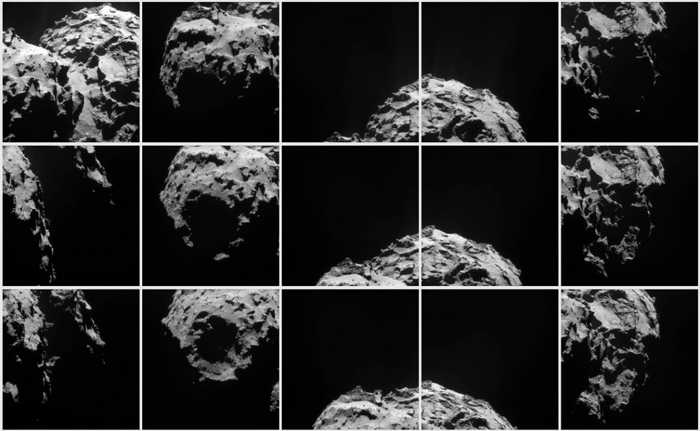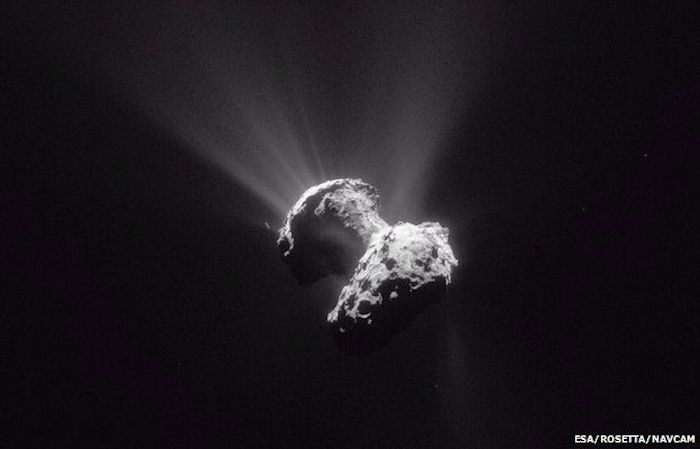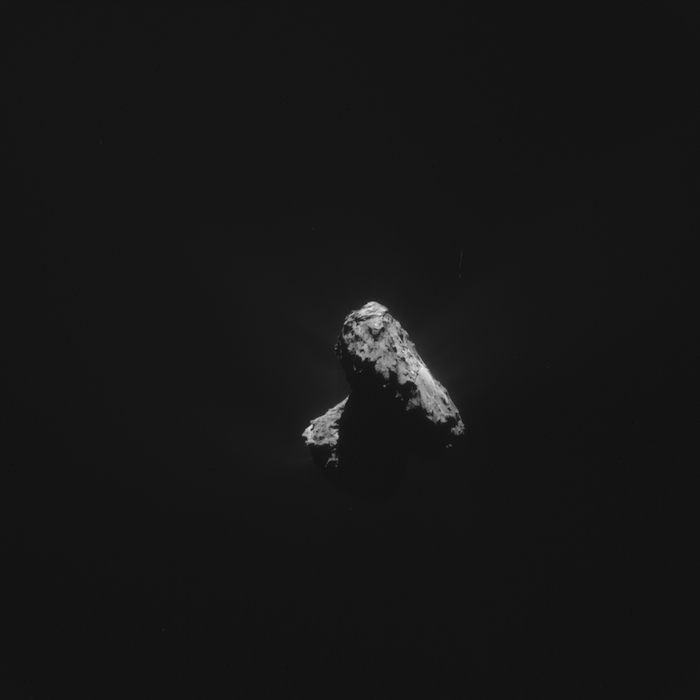.
29.06.2015

Kontakt zu Philae weiterhin unregelmäßig und instabil
Trotz neuer Flugbahn und einer Annäherung an den Kometen Churyumov-Gerasimenko von 200 Kilometer auf 180 Kilometer bleiben die Kontakte zu Lander Philae unregelmäßig und kurz. Nach dem ersten Kontakt am 13. Juni 2015 meldete sich Philae insgesamt noch sechs Mal beim Lander-Kontrollzentrum des Deutschen Zentrums für Luft- und Raumfahrt (DLR) in Köln. Zu den letzten drei berechneten Möglichkeiten für eine Verbindung zu Philae konnten allerdings keine Daten empfangen werden. "Im Moment spielen wir mit der Geometrie zwischen Orbiter Rosetta und Lander Philae", sagt DLR-Philae-Projektleiter Dr. Stephan Ulamec. "Der letzte Kontakt am 24. Juni 2015 dauerte 20 Minuten, allerdings brach die Verbindung immer wieder ab." Nun analysieren die Missionsteams des DLR und der ESA, ob und mit welchen Maßnahmen bessere Kontakte mit Lander Philae möglich sind.
Kommunikation braucht Sonnenlicht
Komet Churyumov-Gerasimenko hat eine Rotationszeit von 12,4 Stunden - und so wäre ungefähr zwei Mal am Erdtag bei einem Überflug von Orbiter Rosetta ein Kontakt möglich. Allerdings müssen dabei gleich mehrere Bedingungen passen, damit Philae über Rosetta und dessen Kontrollraum in Darmstadt Verbindung mit dem DLR-Lander-Kontrollzentrum aufnehmen kann. Zum einen muss Lander Philae in Betrieb sein, und dies kann er derzeit nur bei einer ausreichenden Beleuchtung durch die Sonne und der damit verbundenen Energieversorgung über seine Solarpanele sein. Außerdem müssen die Antenne des Landers und die Antenne des Orbiters aufeinander ausgerichtet sein. Philaes Antennen sind offensichtlich durch Objekte in der direkten, recht harschen Umgebung teilweise beim Senden und Empfangen beeinträchtigt. Auch muss Orbiter Rosetta seine Antenne möglichst genau in Richtung Komet ausrichten.
Vorsicht am aktiven Kometen
Doch Rosetta hat bei ihrem Flug noch andere Umstände zu berücksichtigen. Der zunehmend aktive Komet Churyumov-Gerasimenko schleudert mit seinen Gas-Ausstößen auch Staubpartikel ins All. Diese sorgten bereits im März 2015 dafür, dass die Sternsensoren des Orbiters diese Partikel falsch interpretierten und die Orientierung des Orbiters nicht mehr bestimmen konnten. Damals ging Rosetta automatisch in einen Sicherheitsmodus, entfernte sich vom Kometen und konnte erst dann wieder über Kommandos vom Boden gesteuert werden. Eine weitere Annäherung an Churyumov-Gerasimenko erfolgt daher nur schrittweise und unter ständiger Beobachtung, ob der Orbiter dabei unbeeinträchtigt bleibt. Auch die Flugbahn des Orbiters berücksichtigt derzeit die nicht ungefährliche Umgebung des ausgasenden Kometen. So fliegt Rosetta zurzeit im sogenannten "Terminator"-Orbit entlang der Tag-Nacht-Grenze des Kometen und überfliegt Philae immer am frühen Kometenmorgen - zu diesem Zeitpunkt schaltet sich der Lander allerdings gerade erst ein. "Der Lander wird dann nicht optimal beleuchtet von der Sonne", sagt Philae-Projektleiter Stephan Ulamec. Überflüge zu anderen Tageszeiten am Kometen wurden seit Philaes Aufwachen noch nicht durchgeführt.
Kontakte mit Unterbrechungen
Bei den bisherigen Kontakten mit Philae scheint die Annäherung an den Kometen um 20 Kilometer noch keinen Erfolg gebracht zu haben. "Es gab mehrfach Kontakte, bei denen Philae uns Daten über seinen Status gesendet hat, aber diese Verbindungen waren instabil", erläutert Philae-Projektleiter Stephan Ulamec. Am 19. Juni 2015 empfing das Lander-Kontrollzentrum des DLR in Köln beispielsweise innerhalb von 19 Minuten zwei Mal zwei Minuten lang Daten von Philae. Am 20. Juni 2015 gab es zwar zwei Verbindungen, beide dauerten allerdings jeweils nur etwa eine Minute. Am 23. Juni 2015 meldete sich Philae kurz, konnte aber in dem 20-sekündigen Kontakt keine Daten senden. Beim letzten Kontakt am 24. Juni 2015 dauerte der Kontakt zwar 20 Minuten - die Verbindung war aber ebenfalls nicht stabil, und so sendete Philae insgesamt nur 80 Datenpakete. Zwischen den Kontakten gab es allerdings auch mehrfach berechnete Kontaktzeiten, zu denen keine Verbindung zwischen Philae und Rosetta aufgebaut werden konnte. Auch bei den letzten drei Überflügen von Rosetta in 180 Kilometer Höhe kam kein Kontakt zustande.
Am Samstag beginnt die ESA mit neuen Manövern, die den Rosetta-Orbiter bis zum 30. Juni 2015 um weitere 20 Kilometer näher an die Kometenoberfläche und somit an Philae heranführen. Das Team des DLR-Kontrollzentrums hofft, dass die Kontakte zu Lander Philae bei einer Distanz von dann 160 Kilometern regelmäßiger und stabiler werden. Erst im Laufe der nächsten Tage wird sich zeigen, ob Veränderungen der Geometrie zwischen Lander und Orbiter die Kommunikation mit Philae verbessern.
Angewiesen auf lange und vorhersagbare Kontakte
Auch ein durch die schlechten Bedingungen während des Winterschlafs verursachter Ausfall beispielsweise der Kommunikationseinheiten von Philae wäre ein möglicher Grund für das derzeitige Schweigen des Landers. Die Auswertung der bisher empfangenen Daten durch das Team des DLR hat aber gezeigt, dass zwar eine der beiden Kommunikationseinheiten beeinträchtigt ist, die zweite Einheit jedoch bisher ohne Probleme funktionierte. "Um mit Philae wieder wissenschaftlich zu arbeiten, sind wir auf längere und vorhersagbare Kontaktzeiten angewiesen", betont DLR-Philae-Projektleiter Stephan Ulamec. Nur wenn Philae umfangreiche Kommandos sicher empfangen und ausführen sowie die gemessenen Daten speichern und dann zu seinem Bodenteam senden kann, können seine zehn Instrumente an Bord wieder zum Einsatz kommen.
Quelle: DLR
.
Update: 30.06.2015
.
COMETWATCH 21 JUNE
Today's CometWatch entry is a single frame NAVCAM image taken on 21 June, when Rosetta was 177 km from the centre of Comet 67P/Churyumov-Gerasimenko. The resolution is 15.1 m/pixel and the image measures 15.4 km across.
.

Comet 67P/C-G as viewed on 21 June 2015 from a distance of 177 km to the comet centre. Credits: ESA/Rosetta/NAVCAM – CC BY-SA IGO 3.0
This orientation shows the small comet lobe to the top left, and the large lobe to the bottom right. The image was processed in LightRoom to enhance the comet's activity, which is evident all around the nucleus but appears especially dramatic in the top part of the image.
On the small lobe, the small Serqet region is lit, with its sharp edge separating it from the rough terrains of Anuket, on the comet's neck. At the bottom of Anuket, parts of the smooth Hapi region are visible, while the cliffs of Hathor – also on the neck – are cast in shadow. A diffuse luminosity, likely due to the comet's activity, can be seen also near Hathor.
The large lobe reveals parts of the Seth region, with its characteristic circular features, bordered towards the lower edge by Ash and to the right by the smooth terrains of Anubis. Beyond Anubis, to the far right, is the complex region Atum, and hints of the comet's activity seem to extend below its edge.
Meanwhile, 541 new images have been added to the NAVCAM Archive Image Browser covering the period from 22 November to 19 December 2014, when Rosetta was approximately 20-30 km from the comet centre. Here is a preview of some of the newly released images:
.

The original 1024 x 1024 image of today's CometWatch is provided below:
.

---

Title Comet activity, 21 June
Released 30/06/2015 3:00 pm
Copyright ESA/Rosetta/NavCam – CC BY-SA IGO 3.0
Description
On 13 August 2015, Comet 67P/Churyumov–Gerasimenko will reach its closest point to the Sun along its 6.5-year long orbit. It will be around 185 million km from the Sun at ‘perihelion’, between the orbits of Earth and Mars.
ESA’s Rosetta mission reached the comet on 6 August 2014, and has been accompanying it ever since, monitoring the evolution of the nucleus and its surrounding atmosphere, or coma.
The nucleus is a mixture of frozen ices and dust. As the comet approaches the Sun, solar light warms its surface, causing the ices to boil away. This gas streams away carrying along large amounts of dust, and together they build up the coma.
This image was obtained with Rosetta’s navigation camera on 21 June 2015, when the spacecraft was 177 km from the comet centre.
Parts of the nucleus are lit by sunlight, revealing the variety of terrains that are found on this curious object. The diffuse luminosity, produced by the comet’s activity, is visible all around the nucleus, but appears especially striking in the upper part of the image.
The small lobe of this oddly shaped comet, visible at the top left in this orientation, is crowned by several jets of outflowing material, streaming into space from the surface.
Signs of activity are also visible around the ‘neck’ region that connects the two lobes, set against cliffs that are cast in shadow.
The comet’s large lobe, to the bottom right, reveals the rich morphology of the nucleus, with rugged terrains, circular features and smoother portions punctuated by boulders.
Rosetta will keep observing how the comet’s activity evolves in the lead up to perihelion, and for a full year after that, until the end of the mission in September 2016.
This image is published for the first time in today's CometWatch on the Rosetta blog.
Quelle: ESA
-
Update: 2.07.2015
.
Rosetta erspäht Senklöcher auf Kometen

Collapse exposes the walls that can then also be eroded, eventually softening the pit's appearance
.
The comet being studied by Europe’s Rosetta probe is riddled with pits that formed much like sinkholes here on Earth, say scientists.
They think material under the surface of the icy dirt-ball vaporises in places, resulting in voids that will then no longer support the crust above.
Ceiling collapse produces cylindrical holes that can be more than 100m deep.
Mission researchers say the pits give a view of the inside of 67P.
"They are almost as deep as they are wide," said Jean-Baptiste Vincent, from the Max Planck Institute for Solar System Research in Göttingen, Germany.
"The largest one is about 200m wide and 200m deep.
"It's amazing because it gives us the possibility to look inside the comet for the first time," he told BBC News.
Dr Vincent's team reports its observations in this week's Nature journal.
.

The pits seem to have smooth, flat, dusty floors
.
Sinkholes are a common feature on Earth, especially in landscapes containing easily erodible rock types such as limestone.
Rains and watercourses can slowly eat away at underlying sediments, producing cavities that eventually break through to the surface.
The scientists working on the European Space Agency's Rosetta probe think something similar is happening on Comet 67P/Churyumov-Gerasimenko.
.

Sinkholes are a common feature here on Earth
.
Eighteen pits of interest have been identified on the lit, northern hemisphere of the 4km-wide object.
The theory being posited is that as the comet moves in towards the Sun it will heat up, and buried volatiles will be driven off, opening up hollows.
These voids may already exist to some extent in what is known to be a highly porous body, but the lost volatiles will only exacerbate the situation.
And the dusty, rocky ceilings above the caverns will not be able to support their own weight - even in the low-gravity environment of 67P - and will eventually fall inwards.
This exposes the walls of the pits to direct sunlight, and the ices there are then vaporised.
Pictures from Rosetta clearly show jets of gas and dust shooting away from the walls.
Over time, the sinkholes will likely open out into shallower basins, and these basins will probably also merge.
This knowledge becomes useful for relating the ages of different terrains, because areas that contain many open basins will almost certainly be older than ones with discrete pits.
.

The pits (red arrow) likely open out into shallower basins (white arrows) over time
.
This whole process, the team believes, has a major influence on the look of the craggy, duck-shaped comet.
Of key interest to the scientists is the view the pits are giving of the interior of 67P, and the opportunity this offers to study the object's fundamental structure.
Mission researchers have previously reported the so-called "goosebumps" on the comet. These 1-3m lumps and bumps may be the original icy building blocks that came together to form 67P more than 4.5 billion years ago.
"All the goosebumps we have observed on the comet – they are inside these pits," said Dr Vincent.
.

A fascinating texture: Comet 67P's "goosebumps" have a preferred scale of about 1-3m
.
Rosetta and the comet are currently about 290 million km from Earth and heading in towards the Sun.
Next month marks perihelion, when 67P makes its closest approach to our star, before then sweeping back out into the outer Solar System.
The separation between the comet and the Sun at that point will be some 186 million km, and the increased warmth will drive still more activity. Already, the object is producing spectacular jets, and they will only get more intense.
In addition to making its own observations, Rosetta is also talking to the lander, Philae, which it dropped on to the surface of the comet last November.
Philae has recently come back to life after a period in hibernation.
But Esa controllers need to establish a stable communications link through Rosetta before the little lander can be commanded to resume science observations.
.

The comet is currently throwing off spectacular jets of gas and dust

Quelle: BBC
-
Update: 3.07.2015
.
COMETWATCH 23 JUNE
Today's CometWatch entry shows a view of Comet 67P/Churyumov-Gerasimenko taken on 23 June, when Rosetta was 197 km from the comet centre. This single frame NAVCAM image has a resolution of 16.8 m/pixel and it measures 17.2 km across.
.

NAVCAM image of Comet 67P/C-G taken on 23 June 2015, 197 km from the comet centre. Credits: ESA/Rosetta/NAVCAM – CC BY-SA IGO 3.0
In this orientation, the small comet lobe points to the bottom left, and the large lobe to the top right. The comet's activity, enhanced through image processing in LightRoom, is visible all around the nucleus.
In the foreground, the image shows parts of the Ash region on the large lobe, as well as providing an oblique view on the smooth plains of Imhotep towards the right. Parts of the large lobe, as well as the neck and small lobe, are cast in shadow, and only a small portion of the rough Anuket region is lit. Nevertheless, the full outline of the nucleus can be unmistakably seen as a silhouette against the diffuse glow of the coma.
Today, Rosetta is at around 160 km from the comet and is continuing to fly over the region which is thought to be most optimal to receive a signal from Philae, which is located on the small lobe. However, no further signals from the lander have been received since 24 June and the mission teams are working hard to understand the situation. After careful study of the comet environment, Rosetta will decrease its minimum distance to the comet during next week, up to a closest approach at 155 km.
The original 1024 x 1024 image of today's CometWatch is provided below:
.

Quelle: ESA
.
Update: 6.07.2015
.
Philae comet could be home to alien life, say top scientists
Astronomers say features of comet landed on by spacecraft in November, such as black crust and icy lakes, suggest living micro-organisms beneath surface
The comet landed on by the spacecraft Philae could well be home to an abundance of alien microbial life, according to leading astronomers.
Features of the comet, named 67P/Churyumov-Gerasimenko, such as its organic-rich black crust, are most likely explained by the presence of living organisms beneath an icy surface, the scientists have said.
Rosetta, the European spacecraft orbiting the comet, is also said to have picked up strange clusters of organic material that resemble viral particles.
The European Space Agency pulled off a sensational feat of engineering and captured the imagination of space-travel enthusiasts across the world when Philae landed on the comet in November. Since then, the lander has undergone a period of hibernation from which it awoke in June, having recharged its solar panels.
Neither Rosetta nor Philae are equipped to search for direct evidence of life after a proposal to include this in the mission was allegedly laughed out of court. Astronomer and astrobiologist Prof Chandra Wickramasinghe, who was involved in the mission planning 15 years ago, believes people should be more open to the possibility of alien life.
Wickramasinghe said: “Five hundred years ago it was a struggle to have people accept that the Earth was not the centre of the universe. After that revolution our thinking has remained Earth-centred in relation to life and biology. It’s deeply ingrained in our scientific culture and it will take a lot of evidence to kick it over.”
He and colleague Dr Max Wallis, from the University of Cardiff, believe 67P and other comets like it could provide homes for living microbes similar to the “extremophiles” that inhabit the most inhospitable regions of the Earth.
Comets may have helped to sow the seeds of life on Earth and possibly other planets such as Mars, they argue.
The scientists have carried out computer simulations that suggest microbes could inhabit watery regions of the comet. Organisms containing anti-freeze salts could be active at temperatures as low as -40C, their research shows.
The comet has a black hydrocarbon crust overlaying ice, smooth icy “seas” and flat-bottomed craters containing lakes of re-frozen water overlain with organic debris.
Wickramasinghe said data coming from the comet seems to point to “micro-organisms being involved in the formation of the icy structures, the preponderance of aromatic hydrocarbons, and the very dark surface”.
“These are not easily explained in terms of prebiotic chemistry. The dark material is being constantly replenished as it is boiled off by heat from the sun. Something must be doing that at a fairly prolific rate.”
The astronomers present their case for life on 67P at the Royal Astronomical Society’s National Astronomy Meeting in Llandudno, Wales.
Quelle: The Guardian
.
Update: 7.07.2015
.

Today (6 July) I'm 282million km from Earth, 199million km from the Sun & about 160km from #67P
.

Alan Fitzsimmons
@FitzsimmonsAlan
@ESA_Rosetta this morning from @INGLaPalma for @mggtTaylor @colinsnodgrass at #NAM2015 - there's a comet in the way!
Quelle: ESA
4557 Views
